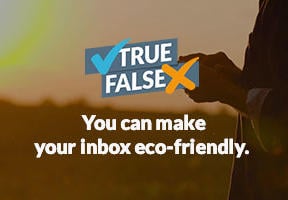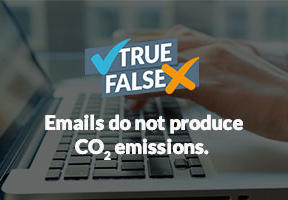On the Shelf: Carbon and Environmental Labeling
5 min read
“Carbon ratings” are starting to make their debut on labels in France. Currently in the trial phase, these labels ultimately aim to inform consumers about the impact their purchases have on emissions. The European Union is also working on an eco-label for use in all E.U. countries.

© THINKSTOCK - Information on the energy cost of products is displayed in supermarket aisles.
After introducing measures to raise consumers’ awareness of the estimated CO2 emissions of a car they are buying or a home they are moving into, the European authorities are now working to add the “greenhouse factor” to the criteria for purchasing consumer goods.
Since 1994, for certain home appliances, European consumers have been in the habit of reading labels that contain information about a product’s energy performance and certain other characteristics, including water consumption and noise levels.
Soon, a wide range of fast-moving consumer goods will feature similar information about their , as part of an initiative led by the European Union. In France, the system is being implemented by the Grenelle I and II Environment Acts. After a 2011-2012 trial with 168 companies found that the various systems needed to be harmonized, companies from the textile, furniture and hotel industries, along with two major retail chains, volunteered in 2017 to take part in the pre-deployment phase, backed by the French Environment and Energy Management Agency (ADEME)1.
The project is now guided by two principles: Labels must indicate more information than simply the product’s rating and take into account the entire life cycle. In addition, labels must feature environmental criteria that extends beyond the product’s .
Taking Into Account the Product’s Entire Life Cycle
The “greenhouse factor” is measured by the carbon rating, also known as the carbon footprint, which is an assessment of total emissions of carbon dioxide (CO2), the main greenhouse gas generated by human activities.
Since the 1990s, it has generally been agreed that a product's carbon footprint should take into account every stage in its life cycle. The of a product or service must therefore include the extraction of the raw materials used to make it, its production, packaging, distribution, use and end-of-life or disposal.
This approach can have some surprising results. Spanish tomatoes sold in the United Kingdom may seem because they have been transported by truck. However, tomatoes produced locally may actually have a larger carbon footprint if they have been grown in greenhouses that need to be heated using oil because of the local climate. The use of plastic packaging, although often criticized, can actually save energy by making it easier to transport and preserve food (see sidebar).
Adopting an Approach Based on Several Criteria
Feedback from the French trial suggests that a product's carbon footprint should not be the only factor taken into account. Other criteria to be considered include resource , potential pollution of air, water or soil, and impact on . Obviously, this would be an environmental label, rather than a carbon label. The trial’s coordinators provided the examples of a laundry detergent or an agricultural product, which, in addition to contributing to , may also have an impact on water quality. Another potential factor is the amount of waste produced and released into the environment. Improving performance in one area should not lower it in another.
Given the number and complexity of the criteria to be taken into account, it is difficult to determine the most effective way of getting the information to consumers so that they can make an informed choice. Should the information be provided on a label directly on the product or on the shelf next to its price, on the customer’s receipt, on posters around the store, or perhaps via a website?
Across the European Union
The European Union is spearheading various labeling initiatives including, as of June 2017, a project to simplify labels for home appliances, with a single A-to-G rating scale2. More broadly, a three-year trial was launched in January 2014 to identify common standards and determine appropriate verification and consumer communication methods.
The difficulty lies in coordinating the initiatives being undertaken in various member countries. In the United Kingdom, for example, major outlets have been using this type of label for several years. Harmonizing the method for calculating the environmental impact of products marketed throughout Europe can quickly become a complex task.
Rethinking Food Packaging to Reduce Waste
Although plastic packaging often suffers from a negative image in the supermarket, it actually offers numerous advantages in terms of energy consumption when the entire product life cycle is taken into account.
- Transportation: Plastic packaging is much lighter than glass, which means that less fuel is needed to deliver goods to the consumer. It also takes up less space, enabling higher vehicle fill rates. In Europe, 10 million metric tons of fuel is avoided each year thanks to plastic packaging.
- Preservation: Plastic packaging is an effective way of preserving food. A cucumber wrapped in plastic film keeps for 11 days longer than an unpackaged cucumber. In the supermarket, loose fruit and vegetables generate 26% more waste than products prepackaged in plastic.
- Recycling: Provided that consumers dispose of it thoughtfully, plastic packaging reduces the amount of waste to be recycled or incinerated after the product has been consumed.
Sources:
- See the ADEME Report (in French only)
- See the Que Choisir consumer association website (in French only)






















